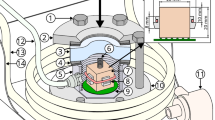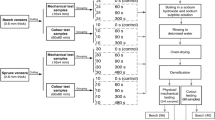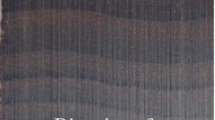Summary
When beechwood is brought into contact with anhydrous ammonia, it swells like in contact with water. Upon removal of the ammonia from the wood, shrinkage is twice as high as before the treatment. Subsequent watering and drying still increase the linear shrinkage of beechwood. In order to find out in which dimensional range there is a reduction of volume in the wood, swelling and shrinkage tests as well as microscopic observations, mercury porosimetry measurements, and density measurements were carried out. The experiments showed that the collapse of the beechwood samples after ammonia treatment is caused by a reduction of the volume of the cell lumina and the perforations of the cell wall. With increasing duration of treatment, first the cell lumina, then the small and smallest pores of the cell walls are partly closed or even eliminated. However, this collapse does not extend to the molecular range. Density measurements even indicate a loosening of the substance during the first hour of ammonia treatment. With increasing duration of treatment, however, this loosening of the substance disappears again.
The changes in the wood caused by ammonia treatment are so substantial that-analogous to ammonia cellulose-the term “ammonia wood” may be applied.
Similar content being viewed by others
References
Bariska, M.; Skaar, C.; Davidson, R. W. 1969. Studies of the wood-anhydrous ammonia system. Wood Sci. 2: 65–72
Bariska, M.; Popper, R. 1971. The behaviour of cotton cellulose and beech wood in ammonia atmosphere. J. Pol. Sci. 36: 199–212
Bariska, M. 1974. Habilitationsschrift, ETH Zürich. Unpublished
Bariska, M.; Popper, R. 1975. NH3 sorption isotherms of wood and cotton cellulose. Wood Sci. Technol. 9: 151–161
Barry, A. J.; Peterson, F. C.; King, A. J. 1936. X-ray studies of reactions of cellulose in nonaqeuous systems. I. Interaction of cellulose and liquid ammonia. J. Am. Chem. Soc. 58: 333–337
Berzinš, G. W. 1972. Holzplastifizierung als Weg zur qualitätserhöhenden Werkstoffsubstitution. Holztechnol. 13: 103–110
de Boer, J. H. 1936. The influence of van der Waals' forces and primary bonds on binding energy, strength, and orientation with special reference to some artificial resins. Trans. Faraday Soc. 32: 10–38
Davidson, G. F. 1927. The specific volume of cotton cellulose. J. Text. Inst. 18: 175
Davidson, R. W. 1968. Private communication
Fukada, E. 1968. Piezoelasticity as a fundamental property of wood. Wood Sci. Technol. 2: 299–307
Gonet, B. 1973. Der Einfluß des Dämpfens auf die Eigenschaften von Rotbuchenholz. Holztechnol. 14: 70–72
Guyer jr., A.; Böhlen, B.; Guyer sr., A. 1959. Über die Bestimmung von Porengrößen. Helv. Chimica Acta 42: 2103–2110
Hermans, P. H. 1949. Physics and chemistry of cellulose fibers. Elsevier Publ. Co. Inc., New York/Amsterdam/London/Bruxelles
Kürschner, K. 1966. Chemie des Holzes. 2. Aufl. Berlin: Techn. Verl. H. Cram
Milis, J. M. 1956. A rapid method of constructing linear density gradient columns. J. Pol. Sci. 19: 585–587
Nayer, A. N.; Hossfeld, R. L. 1949. Hydrogen bonding and the swelling of wood in various organic liquids. J. Am. Chem. Soc. 71: 2852–2855
Necešaný, V. 1961. bei Gonet, B. 1973.
Newlin, J. A.; Wilson, T. R. C. 1919. The relation of the shrinkage and strength properties of wood to its specific gravity. U.S. Dept. Agr., Washington, Bull. No. 676
Parham, R. A.; Davidson, R. W.; de Zeeuw, C. H. 1972. Radial tangential shrinkage of ammoniatreated Loblolly pine wood. Wood Sci. 4: 129–136
Pollisco, F. S. 1969. Physical properties of maple wood treated with ammonia vapor. Dissertation, State Univ. Syracuse, New York
Purves, C. B. 1946/47. Seventh annual report of the Pulp and Paper Research Institute. Montreal, Can.
Runkel, R. O. H. 1951. Zur Kenntnis des thermoplastischen Verhaltens von Holz. Holz Roh-Werkstoff 9: 41–53
Schuerch, C. 1964. Wood Plasticization. Forest Prod. J. 14: 377–381
Stamm, A. J. 1955. Swelling of wood and fiberboards in liquid ammonia. Forest Prod. J. 5: 413–416
Tiemann, H. D. 1915. Principles of kiln drying. Lumber World Rev.
Wang, P. Y.; Bolker, H. I.; Purves, C. B. 1967. Uronic acid ester groups in some softwoods and hardwoods. Tappi 50: 123–124
Wardrop, A. B. 1964. The structure and formation of the cell wall in xylem. Cited by Zimmermann, M. H. 1964: The formation of wood in forest trees. Academic Press, Inc., New York
Washburn, E. W. 1921. Note on a method of determining the distribution of pore sizes in a porous material. Proc. Nat. Acad. Sci. 7: 115–116
Weast, R. C.; Selby, S. M. 1974/75. Handbook of chemistry and physics. 55th Edit. Cleveland: The Chemical Rubber Co.
Author information
Authors and Affiliations
Additional information
This investigation was sponsored by the “Zentenarfonds” of the Swiss Federal Institute of Technology. The support of this research work is gratefully acknowledged. This article represents a part of the habilitation thesis submitted by the author to the Swiss Fed. Inst. of Technology with the title “Physikalische und physikalisch-chemische Änderungen im Holz während und nach NH3-Behandlung.”
Rights and permissions
About this article
Cite this article
Bariska, M. Collapse phenomena in beechwood during and after NH3-impregnation. Wood Science and Technology 9, 293–306 (1975). https://doi.org/10.1007/BF00353479
Received:
Issue Date:
DOI: https://doi.org/10.1007/BF00353479




